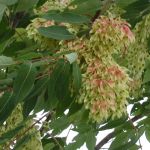| Common Name: |
Ailanto |
| Other Names: |
Tree of Paradise, Chinese sumac |
| Botanical Name: |
Ailanthus altissima syn. A. glandulosa |
| Genus: |
Ailanthus |
| Family: |
Simaroubaceae |
| Native Location: |
China |
| Cultivation: |
Fertile, well-drained soil in sun or partial shade. In spring, cut plants grown as shrubs back hard to encourage production of very large leaves. Tolerates urban pollution. Ailanthus altissima is subject to statutory control as a weed in parts of Australia. |
| Propagation: |
By seed sown in autumn (slow to germinate); by suckers or root cuttings in winter. |
| Harvest: |
Bark is removed in spring and dried for decoctions and tinctures. |
| Height: |
25m (80ft) |
| Width: |
15m (50ft) |
| Hardiness: |
Z4-8 |
| Parts Used: |
Bark (chun pi). |
| Properties: |
A nauseatingly bitter, astringent herb that lowers fever, relaxes spasms, and slows the heart rate. Readily causes vomiting. |
| Medicinal Uses: |
Internally for malaria, asthma, palpitations, diarrhea, dysentery, hemorrhoids, heavy menstruation, and tapeworms. |
| Bibliography: |
Encylopedia of Herbs by Deni Brown Copyright ©: 1995, 2001 Dorling Kindersley Limited pp 107-108
|

